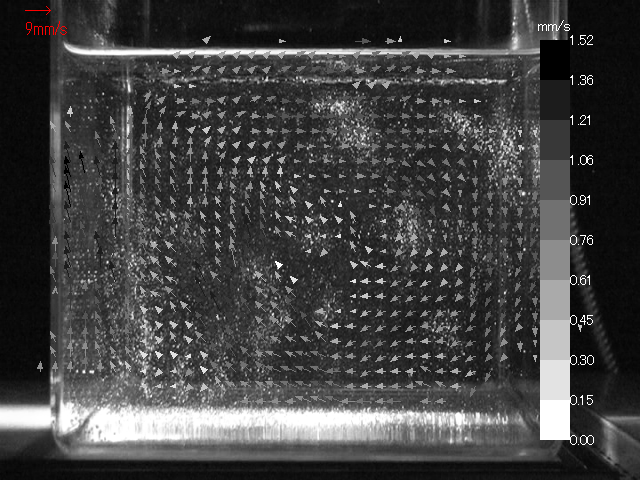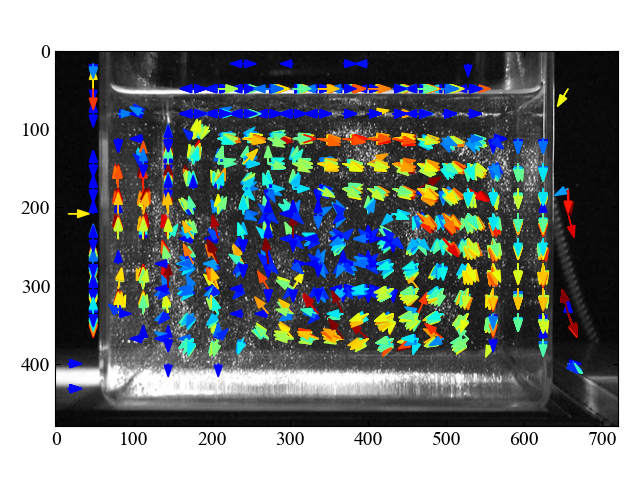舞鶴高専の4年生,機械工学実験のテーマの1つに『自然対流の可視化とPIV計測』という実験があります.
以下のような解析結果を出しますが,PCの老朽化に伴う機種更新の検討過程で,フリーな環境でもPIV計測できる可能性を発見したので,ここに公開します.

オリジナルは WATLABブログ さんの Python/OpenCVでPIV計測!粒子移動をベクトル化する を参考にさせてもらいました.先人の知恵に感謝! また,ここで紹介するコードは GitHub にて公開しています. opencv-python, numpy, matplotlib の各ライブラリを使用するのでインストールしておいてください.
import os
import argparse
import cv2
import numpy as np
## 使い方
## py avislice.py -h
def m_slice(path, out, step):
movie = cv2.VideoCapture(path) # 動画の読み込み
Fs = int(movie.get(cv2.CAP_PROP_FRAME_COUNT)) # 動画の全フレーム数を計算
ext_index = np.arange(0, Fs, step) # 静止画を抽出する間隔
for i in range(Fs - 1): # フレームサイズ分のループを回す
flag, frame = movie.read() # 動画から1フレーム読み込む
check = i == ext_index # 現在のフレーム番号iが、抽出する指標番号と一致するかチェックする
# frameを取得できた(flag=True)時だけ処理を行う
if flag: # == True
# もしi番目のフレームが静止画を抽出するものであれば、ファイル名を付けて保存する
if True in check:
# ファイル名は後でフォルダ内で名前でソートした時に連番になるようにする
path_out = out + '\\' + str(i).zfill(5) + '.png'
print(path_out)
cv2.imwrite(path_out, frame)
return
# 引数処理
parser = argparse.ArgumentParser(description='動画ファイルから静止画を出力します.')
parser.add_argument('inFile', help='分割したい動画ファイル名.漢字を含むフォルダやファイル名はやめておきましょう.')
parser.add_argument('-o', '--outFolder', help='出力フォルダ.省略すると動画ファイル名と同じフォルダが作られます.')
parser.add_argument('-s', '--split', type=int, default=10, help='動画スキップ数.')
args = parser.parse_args()
if not args.outFolder:
args.outFolder = os.path.splitext(os.path.basename(args.inFile))[0]
if not os.path.exists(args.outFolder):
os.mkdir(args.outFolder)
# 関数実行:引数=(ファイル名のパス、保存先のフォルダパス、静止画拡張子、ステップ数)
m_slice(args.inFile, args.outFolder, args.split)
たとえば py avislice.py sample\s0.avi のように実行すると,s0 というフォルダに連続静止画(png)を出力します. どれくらいの動画フレームで出力するかは '-s' オプションで指示します. py avislice.py sample\s0.avi -s 1 とすると,1フレームずつ出力されます.デフォルトは 10 です.
import cv2
import os
import argparse
import glob
import numpy as np
from matplotlib import pyplot as plt
## PIV解析をする関数
## 使い方
## py piv.py -h
def piv(dir, out, threshold, wsize=32, overlap=0):
count = 0
path_list = sorted(glob.glob(os.path.join(*[dir, '*']))) # ファイルパスをソートしてリストする
# グラフ初期化
plt.rcParams['font.size'] = 14 # フォントの種類とサイズを設定する。
plt.rcParams['font.family'] = 'Times New Roman'
plt.rcParams['xtick.direction'] = 'in' # 目盛を内側にする。
plt.rcParams['ytick.direction'] = 'in'
# グラフの上下左右に目盛線を付ける。
fig = plt.figure()
ax1 = fig.add_subplot(111)
ax1.yaxis.set_ticks_position('both')
ax1.xaxis.set_ticks_position('both')
# 背景画像の用意と表示設定
img = cv2.imread(path_list[0], 0) # 最初の画像を背景画像とする
ax1.imshow(img, cmap='gray') # 背景画像
cm = plt.get_cmap('jet') # カラーマップ
vsf = 2 # ベクトル表示のスケールファクタ
# 全画像ファイルをリストしてPIV計算を実施
for i in range(len(path_list)-1):
count += 1
vectors_amps = [] # ベクトルの大きさ情報を格納する空配列
coordinates = [] # 座標情報を格納する空配列
correlation_coef = [] # 相関係数情報を格納する空配列
# グレースケール画像で2枚(i, i+1)の画像を読み込み
img1 = cv2.imread(path_list[i], 0)
img2 = cv2.imread(path_list[i+1], 0)
# 画像サイズを取得
h, w = img1.shape
h2, w2 = img2.shape
# ファイルサイズが揃っていない場合はエラー
if h != h2 or w != w2:
print('Error:img(i).shape != img(i+1).shape.')
print('Align image size.')
break
w_st = int(w / (wsize - overlap)) # 幅のストライドを計算
h_st = int(h / (wsize - overlap)) # 高さのストライドを計算
# 画像を走査しながら処理をする(h_st, w_stのサイズでループ)
for k in range(h_st-1):
for j in range(w_st-1):
# テンプレートマッチング部分-------------------------------------------------------------
# 抽出範囲の点(左上、右上)を計算
p_h1 = k * (wsize - overlap)
p_h2 = p_h1 + wsize
p_w1 = j * (wsize - overlap)
p_w2 = p_w1 + wsize
# パターンマッチングから移動先座標を計算
template = img1[p_h1:p_h2, p_w1:p_w2] # img[i]からテンプレート画像を抽出
method = cv2.TM_CCOEFF_NORMED # NCC(正規化相互相関係数)を選択
res = cv2.matchTemplate(img2, template, method) # img[i+1]に対するテンプレートマッチングの結果
min_val, max_val, min_loc, max_loc = cv2.minMaxLoc(res) # 最小値と最大値、その位置を取得
# テンプレート画像の中心座標を計算
before_w = int(p_w1 + (p_w2 - p_w1) / 2) # 探査前のx座標
before_h = int(p_h1 + (p_h2 - p_h1) / 2) # 探査前のy座標
after_w = int(max_loc[0] + wsize / 2) # 探査後のx座標
after_h = int(max_loc[1] + wsize / 2) # 探査後のy座標
# 評価指標を計算
dx = after_w - before_w # x増分値
dy = after_h - before_h # y増分値
vector_amp = np.sqrt(dx ** 2 + dy ** 2) # ベクトルの大きさ
coordinate = [before_w, before_h, dx, dy] # 座標と増分値セット
# データ格納
vectors_amps.append(vector_amp)
coordinates.append(coordinate)
correlation_coef.append(max_val)
# ----------------------------------------------------------------------------------
# ここからグラフ描画-------------------------------------
# 誤ベクトル処理(一度に一定ピクセル(threshold)以上のベクトルは長さを0にする)
for m in range(len(vectors_amps)):
# print(m, '/', len(vectors_amps)-1)
if vectors_amps[m] >= threshold:
coordinates[m][2] = 0
coordinates[m][3] = 0
vectors_amps[m] = 0
# 誤ベクトル処理後のベクトルをMin-Max正規化(cmapでベクトルに色を付けるためだけの変数)
norm_vectors = (vectors_amps - np.min(vectors_amps)) / (np.max(vectors_amps) - np.min(vectors_amps))
# 画像にベクトルをプロットする
for n in range(len(vectors_amps)):
# print(n, '/', len(vectors_amps)-1) # 進捗表示
# 長さ0以外の場合に図にベクトル(dx, dyにそれぞれスケールを乗じた後のベクトル)を描画
if vectors_amps[n]: # != 0
ax1.arrow(x=coordinates[n][0], y=coordinates[n][1],
dx=vsf * coordinates[n][2], dy=vsf * coordinates[n][3],
width=0.01, head_width=10, color=cm(norm_vectors[n]))
# 画像作成の進捗を表示
print(count, '/', len(path_list) - 1)
# レイアウトタイト設定
fig.tight_layout()
plt.savefig(out)
return
# 引数処理
parser = argparse.ArgumentParser(description='連続静止画からPIV可視化を行います.')
parser.add_argument('inFolder', help='連続静止画が保存されているフォルダ名.漢字を含むフォルダやファイル名はやめておきましょう.')
parser.add_argument('-o', '--outFile', help='出力フォルダ.省略すると入力フォルダ名と同じ名前のpngファイルに出力されます.')
parser.add_argument('-t', '--threshold', default=10, type=int, help='誤ベクトルのしきい値.デフォルト=10')
args = parser.parse_args()
if not args.outFile:
args.outFile = os.path.splitext(os.path.basename(args.inFolder))[0] + '.png'
# PIV解析の関数を実行
piv(args.inFolder, args.outFile, args.threshold)
たとえば py piv.py s0 のように実行すると,s0フォルダにある連続静止画から s0.png というPIV解析結果の画像ファイルを出力します.

市販のPIV計測ソフト(Flow-vec)が50マン円ですからね~ すごい時代になりました.